The challenge of measuring product marketing success is not a new one. Nearly every marketing leader I’ve asked about measuring the impact of this function has stated how difficult it is, in part because product marketing KPIs are not especially intuitive. With marketing moving more and more in the direction of data-driven decisions and results, it becomes quite the challenge when marketers are unable to attribute tangible results to a team’s effort.
While it is difficult, it is not impossible to measure the impact of product marketing. In fact, we may simply be at the earliest stages of developing tools and strategies for measuring the role. Product marketing is a diverse function serving many different stakeholders, and the role and priorities can vary significantly from company to company.
“Virtually every other aspect of marketing is almost purely data driven today, but product marketing has lagged behind. I think this is partly due to the lack of tools and technologies that target the product marketing function, but it is also challenging because product marketing serves so many different constituents that are all using different metrics, tools, and time horizons to measure themselves.”
- Rob Bois, Sr. Dir. Product Marketing, Fuze
After talking with many top marketing leaders and product marketing pros, I pulled together the takeaways in our new Guide to Measuring Product Marketing, which covers:
- The Role of Product Marketing
- Challenges with Measuring Impact
- Key Product Marketing Metrics
- Qualitative vs. Quantitative Metrics
- How to Overcome Measurement Challenges
For a sneak preview, here are key metrics being used by the best marketing teams today.
8 Key Product Marketing Metrics
While even the most experienced (and humble) marketers will admit metrics are a constant work in progress, there are already some common approaches to measurement. These key product marketing metrics typically fall into three areas.
Key Business Metrics (& Leading Indicators)
1) Overall Revenue Goal
Pretty much every product marketing team will list overall revenue among their metrics, a reflection of the diverse nature of their efforts that are ultimately meant to impact this goal. This includes new acquisition and upsell/cross-sell/retention targets, and depending on the business and organizational goal, there will be a different level of focus on each. This can also trickle down into related goals, like number of new customers acquired, retention rates, and average revenue per customer.
“Two of the most important KPIs that we focus on within product marketing is number of signed customers in addition to average customer value (ARR). Given the long-term and strategic nature of PMM projects, measurement is sometimes difficult on individual initiatives. That said, results of the business and your company’s go-to-market efforts are the best proxy for your PMM team’s performance.”
- Derek Stangle, Director Product Marketing, Toast
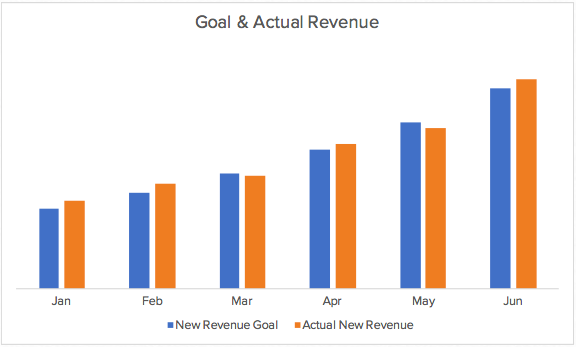
2) Win Rates
Sales success as measured by win rates is a key contributor to the company’s ability to hit revenue goals, and can more closely reflect product marketing’s efforts. Measuring overall win rates as well as slicing this data by sales team, product, and competitor, can uncover strengths and opportunities and more closely direct and recognize the effort of the product marketing team.
"We want to dominate the relevant market with each product, so we look at market share, competitive win/loss rates, brand perception based on an external survey, and overall revenue growth.”
- Prashant Kaw, Sr. Director Demand Gen, DevTools, Progress
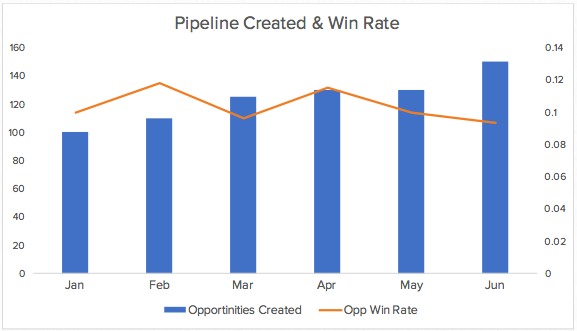
3) Product Launch Metrics
Product launches are a microcosm of the product marketing team's go-to-market strategy. They represent a focus on driving awareness, demand, sales, and usage of a new product or feature. As such, product marketing can set specific goals around each of those areas in conjunction with other teams like demand gen.
Sample product launch metrics include:
- Trials started or demos requested
- Content views, including product page views and video views
- Press coverage for the announcement
- New customer or upgrade revenue
- Product usage or adoption of a new feature
Be sure to set a timeframe for product launch metrics - for example, to increase Feature X usage by 10% within 90 days of launch. This is key for helping attribute results to the launch effort, and to be able to close out the campaign and report on results.
“Our ‘one metric that matters’ is opportunity dollar value. This has the added bonus of being fairly easy to figure out on a macro level. Each campaign then has micro goals (e.g. awareness, traffic, conversion, etc.). For product marketing, we look at revenue dollars influenced (e.g. from ABM projects and proofs of concept) and inbound marketing metrics for down-funnel CTAs (measuring if our crafted story performed).”
- Jenn Steele, Senior Director Product Marketing, Indix
4) Product Usage
Product usage is another metric that can lead to overall revenue, specifically if the company has identified that usage of features A, B, C correlate with higher retention rates, higher revenue, or more upsells/cross-sells. Tracking product usage is likely a shared responsibility with product management, and product managers may very well also be tasked with improving certain usage metrics. Product marketing, however, may lead campaigns around improving usage of key features in order to impact retention and revenue.

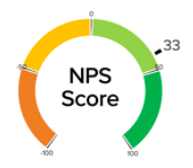
5) Customer Happiness and Retention
Similar to product usage, customer happiness metrics - such as NPS (Net Promoter Score) - can correlate with other key revenue metrics and be a relevant product marketing goal. Retention rates are an even more direct metric to align customer happiness with revenue goals.
Qualitative Feedback
6) Internal Qualitative Feedback
Quantitative KPIs don’t tell the whole story, so most teams will leverage qualitative feedback as well. Specifically, internal surveys to various stakeholders serve as avenues to measure the impact on each of the teams that leverage product marketing output.
“I think of my role in product marketing as a sales accelerator. So that means my job is to do a number of different things to help the company be more effective in selling. I send a survey to the team at the beginning of every quarter. This helps me understand what they need, but also how I’m doing as a product marketer in supporting them. I believe in getting as much feedback as possible from every team I work with, but especially Sales.”
- Aaron Levin, Product Marketing Lead, BetterWorks
Sample sales survey questions include:
- On a scale of 1 to 5, how supported do you feel?
- What assets (collateral, videos, etc.) have you used in the last month that have made you more successful?
- If Marketing could do one thing to help you succeed, what would that be?
- Compared to the previous quarter, how would you rate lead quantity and quality?
- Compared to the previous quarter, do prospects seem to have greater, less, or the same level of awareness of our company?
Similar surveys can be run to get feedback from each of product marketing’s stakeholders - from sales to product management to executive leadership.
7) External Qualitative Feedback
External surveys can also provide useful qualitative feedback that can be turned into quantitative measures. For example, if product marketing is working on driving awareness of specific differentiation, surveys that ask prospects how they see each company in the market can show whether the differentiation efforts are or are not working.
With any qualitative feedback, there’s an opportunity to both draw out quantitative measures as well as qualitative themes. The quantitative measures - e.g. 60% of prospects correctly described Acme as a fictional corporation from the Road Runner cartoons - can help provide concrete goals to target. And the qualitative themes - e.g. sales reps cited the videos have been great but wish they knew which video to send to which prospect - help provide actionable feedback and direction for potential action items.
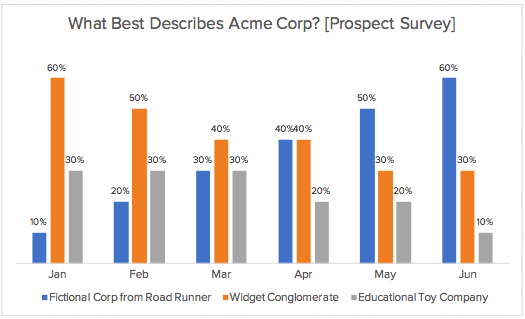
“When it comes to the qualitative vs. quantitative debate in marketing, it all comes down to balance. I’ve seen too many good marketers sacrifice quality to hit short-term goals, which only ends up hurting your team in the long run. If your primary goals are centered on producing quality work, the metrics will take care of themselves (to paraphrase Bill Walsh)."
- Ben Austin, Product Marketing Manager, Carbon Black
Specific Asset Usage
8) Usage of Product Marketing Assets
Finally, the most direct and tactical measure is usage of a product marketing asset, such as a datasheet or case study. If a piece of sales collateral is used frequently, that can be an indication that the sales team finds it useful. A similar conclusion can be made if the product team implements the input provided based on product marketing’s market analysis. While this type of KPI can be somewhat disconnected from bottom-line business goals like revenue, it can more directly reflect the value attributed to product marketing’s effort.
"I prefer to measure success based on areas where Product Marketing has greater ownership, including number of direct customer/prospect engagements, sales cycle length, product/feature adoption, sales enablement surveys, and providing roadmap guidance.”
- Darr Gerscovich, B2B Enterprise Marketing Leader with experience ranging from large corporations (Yahoo, LinkedIn) to small SaaS tech companies (Ensighten, DroneDeploy)
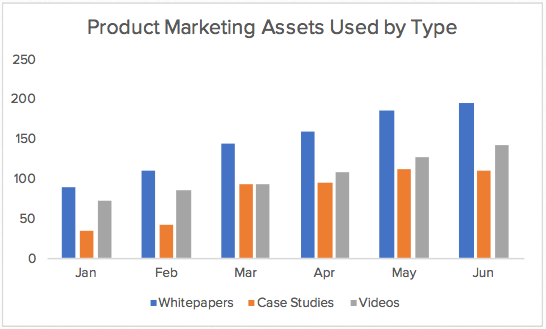
Oftentimes, product marketers will choose a combination of metrics, or the key metrics at a given time will change based on current priorities and company stage.
“When you're just starting out, measuring product marketing is a little bit more ‘Do we have X?’ and as you get more sophisticated, it's more ‘How is X performing?’"
- Juliette Kopecky, VP Marketing, Talla
It is product marketing's strategic and interconnected role that, while difficult to measure, leads to great business impact. Sitting at the intersection of many departments and executive leadership means that many of the above metrics have hints of each of those team's metrics.
“Product marketing’s role is to quarterback the go-to-market of the organization. That includes everything from identifying and segmenting the target audience, to crafting the messaging, to supporting the go-to-market needs of Product, Sales, and Marketing.”
- Jessica Iandorio, SVP Marketing, Mirakl
Whether you’re just establishing your product marketing metrics or a pro evaluating each of these key areas, we’ve turned the above into a guide and template to make this easier. Download the Guide to Measuring Product Marketing + Bonus Template here.
Product marketing measurement is indeed a work in progress, but many companies are circling in on good practices around how to measure and report on the effect of this team. Have additional metrics or approaches that you use? Please reach out and share - we’d love to hear from you!

Related Blog Posts
Popular Posts
-
 How to Create a Competitive Matrix (Step-by-Step Guide With Examples + Free Templates)
How to Create a Competitive Matrix (Step-by-Step Guide With Examples + Free Templates)
-
 Sales Battlecards 101: How to Help Your Sellers Leave the Competition In the Dust
Sales Battlecards 101: How to Help Your Sellers Leave the Competition In the Dust
-
 The 8 Free Market Research Tools and Resources You Need to Know
The 8 Free Market Research Tools and Resources You Need to Know
-
 6 Competitive Advantage Examples From the Real World
6 Competitive Advantage Examples From the Real World
-
 How to Measure Product Launch Success: 12 KPIs You Should Be Tracking
How to Measure Product Launch Success: 12 KPIs You Should Be Tracking




